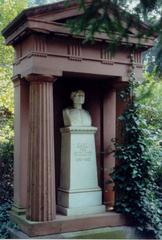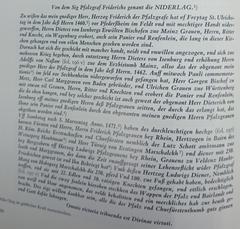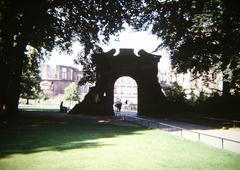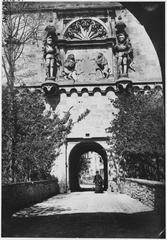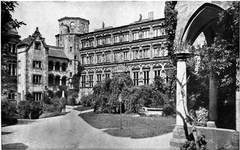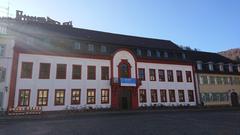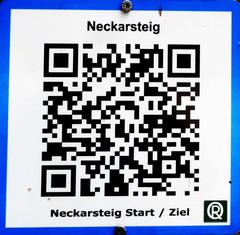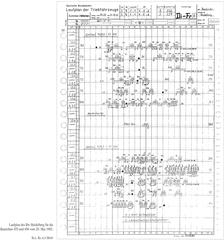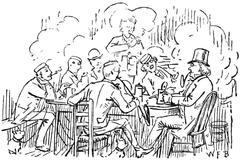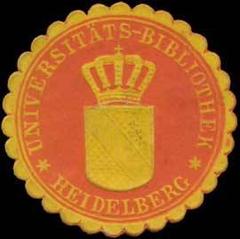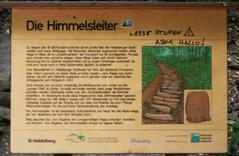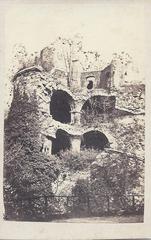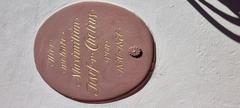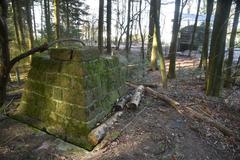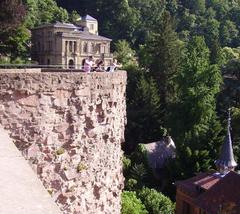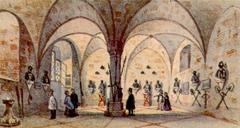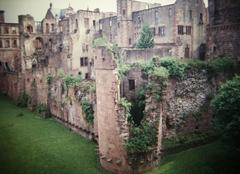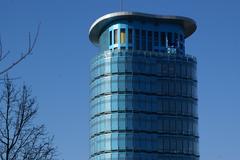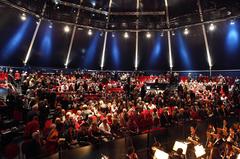
Castle Rohrbach Visiting Hours, Tickets, and Guide to Heidelberg Historical Sites
Date: 04/07/2025
Introduction
Nestled in the picturesque Rohrbach district of Heidelberg, Germany, Castle Rohrbach (Schloss Rohrbach) is a hidden gem that offers visitors a tranquil escape and a fascinating journey through centuries of local history. Situated within the grounds of the Thoraxklinik Heidelberg, the castle—sometimes called the Rohrbacher Schlösschen—blends neoclassical elegance, medieval remnants, and lush parkland. While often overshadowed by the iconic Heidelberg Castle, Castle Rohrbach is a meaningful destination for those interested in the layered heritage, architecture, and community life of Heidelberg.
This comprehensive guide provides up-to-date details on Castle Rohrbach visiting hours, ticketing, accessibility, guided tours, and nearby attractions. It also explores the castle’s historical significance and its role within Heidelberg’s cultural landscape, equipping you to plan a rewarding visit.
Historical Overview
Early Settlement and Medieval Origins
The Rohrbach area boasts a history of human habitation dating back to prehistoric times, with archaeological evidence pointing to Stone Age settlements. The name “Rohrbach” is derived from a stream lined with reeds, reflecting the district’s natural landscape. Rohrbach first appeared in written records as early as 766 CE, making it one of Heidelberg’s oldest settlements (heidelberg.de).
During the Middle Ages, Rohrbach developed as an agricultural and winegrowing community. The strategic location of Castle Rohrbach, built during the High Middle Ages, provided oversight of the plains south of Heidelberg and played a role in regional defense, governance, and economic activity. The castle’s medieval ruins bear witness to the feudal and military importance of the site during this era (europescastles.com).
Renaissance and Neoclassical Transformations
As the Renaissance swept through the Palatinate, Castle Rohrbach underwent architectural modifications. Additions such as larger windows and decorative facades reflected the changing tastes and increasing comfort of its noble residents. The neoclassical manor seen today dates to the late 18th or early 19th century and features symmetrical forms, arched windows, and a prominent three-axial central projection (stadtteilverein-rohrbach.de; de.wikipedia.org).
Modern Developments and Community Role
With industrialization and urban expansion in the 19th and 20th centuries, the castle’s function shifted. Today, Schloss Rohrbach serves institutional purposes within the Thoraxklinik campus, while its park is cherished as a public green space and venue for community events. Preservation efforts and local engagement ensure that the castle remains a vibrant part of Heidelberg’s cultural memory (stadtteilverein-rohrbach.de).
Visiting Information
Visiting Hours and Ticketing
- Park Hours: The park surrounding Castle Rohrbach is open daily from dawn until dusk, typically 8:00 AM to sunset.
- Castle Interior: The manor interior is not generally open to the public, except during occasional special events or guided tours.
- Admission: There is no entrance fee for the castle grounds and park. Fees may apply for special tours or events.
How to Get There
- Public Transportation: Bus and tram connections from central Heidelberg reach Rohrbach in 15–20 minutes.
- Cycling/Walking: Scenic routes connect the city center with Rohrbach, and the park is accessible via Parkstraße.
- Parking: Limited street parking is available nearby; public transit is recommended during busy times.
Accessibility
- Pathways: Most paths in the park are flat and suitable for wheelchairs and strollers.
- Interior Access: The castle’s interior is only accessible during special events, and may present challenges for those with limited mobility.
- Restrooms: Public restrooms are not always available on-site; facilities in Rohrbach district are recommended.
Guided Tours and Events
- Guided Tours: Not offered regularly, but local heritage days and festivals sometimes include guided tours or open-house events. Check the Stadtteilverein Rohrbach website or the official Heidelberg tourism site for announcements.
- Cultural Events: The park hosts open-air concerts, community festivals, art exhibitions, and outdoor theater performances, especially in spring and summer (Komoot).
Architectural and Cultural Highlights
- Neoclassical Manor: The current building showcases late 18th/early 19th-century neoclassical architecture, including a decorative frieze and symmetrical design.
- Medieval Ruins: Remnants of the earlier medieval castle offer insight into defensive architecture and regional history.
- Park and Grounds: Lush gardens, mature trees, benches, and a small pond create a serene environment for walking and relaxation.
- Community Significance: The site is central to Rohrbach’s local identity, with regular events fostering cultural engagement (stadtteilverein-rohrbach.de).
Practical Visitor Tips
- Best Time to Visit: Spring for blooming gardens, autumn for colorful foliage; early mornings or weekdays for a quieter experience.
- Facilities: Benches, trash bins, and accessible walking paths are available. No on-site café, but Rohrbach district offers dining options.
- Etiquette: Respect the peaceful environment by keeping noise low, disposing of litter properly, and avoiding damage to plants or historical features.
- Pets: Dogs are welcome on leashes; owners must clean up after pets.
Nearby Attractions
- Heidelberg Castle: The city’s most famous landmark, easily reached by tram or bus.
- Old Town (Altstadt): Explore historic streets, shops, and cafés.
- Philosophenweg (Philosopher’s Walk): A scenic walking trail with panoramic views.
- Tiefburg Castle (Handschuhsheim): Another historical site worth visiting (PassingThru).
Frequently Asked Questions (FAQ)
Q: What are Castle Rohrbach’s visiting hours?
A: The park is open from dawn to dusk, typically 8:00 AM to sunset. Interior access is event-dependent.
Q: Is there an entrance fee?
A: No, visiting the park and exterior is free. Fees apply only to special tours or events.
Q: Are guided tours available?
A: Not regularly. Special events may include guided tours—check local listings in advance.
Q: Is Castle Rohrbach wheelchair accessible?
A: The park has mostly flat, accessible paths; interior access may be limited.
Q: How do I get there from Heidelberg city center?
A: Take public transit (tram/bus) to Rohrbach, cycle, or walk; parking is available nearby.
Visual Gallery
Alt text: Neoclassical facade of Schloss Rohrbach surrounded by gardens
Alt text: Tranquil park area with walking paths and mature trees at Schloss Rohrbach
Planning Your Visit: Key Points
- Castle Rohrbach offers serene park grounds, evocative ruins, and community events, all free of charge.
- Accessibility by public transport and flat park paths make it suitable for all visitors.
- Check official tourism platforms for updates on special events, guided tours, and seasonal hours.
- Combine your visit with other Heidelberg historical sites for a full cultural experience.
- Download the Audiala app for audio guides, insider tips, and the latest visitor information.
Sources
- Stadtteilverein Rohrbach
- Europes Castles
- Komoot: Castles Around Heidelberg
- PassingThru: Heidelberg Germany Castles
- Official Heidelberg Tourism
- Europe for Visitors
Internal Links
- Heidelberg Castle: Visiting Hours and Ticket Information
- Top Historical Sites in Heidelberg
- Guide to Heidelberg’s Old Town
Conclusion and Call to Action
Castle Rohrbach is a tranquil and historically rich site that rewards visitors with its blend of medieval legacy, neoclassical architecture, and vibrant community events. Easily accessible and free to explore, it is an ideal addition to any Heidelberg itinerary. Stay informed about special events and tours by checking the official tourism sites and consider using the Audiala app for interactive guides and up-to-date information. Experience the unique story of Rohrbach and discover the quieter side of Heidelberg’s history.

